Features & Columns
Weird Eats
and a lot more
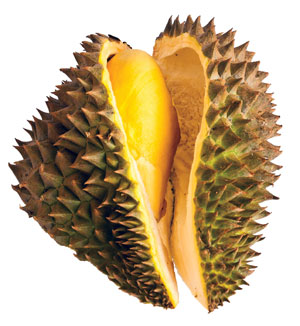 DURIAN: The Sewer-scented fruit
DURIAN: The Sewer-scented fruit
Thanks to Silicon Valley's diverse, ever-changing population, it isn't necessary to travel to Bangkok or watch Bizarre Foods to experience some truly weird cuisine. We've got plenty of it right here. Marinated pig's ear? Sewer-scented fruit? Fried grasshoppers? Cow brain tacos? Silicon Valley has it all.
What follows is a survey of some of our region's most bizarre foods. For those who grew up in America, these items may read like a gallery of gastronomic horrors. Others may just recall the taste of home.
When it comes to what we put in our mouths, there are certain lines most of us won't cross. But these barriers are actually less fixed than we might think. An open mind can lead to an open mouth. What's weird and exotic is all a matter of perspective.
We all know Einstein's theory of relativity. As the theory goes, space and time are not fixed, but relative. Well, I have my own theory of relativity.
I call it the theory of culinary relativity. It goes like this: Our tastes and predilections are neither innate nor fixed. They are a product of this moment in time and our acculturation. What we eat depends on where we are, not who we are.
We may regard what we like and dislike as fixed markers of our identity, but "the great preponderance of the evidence argues against permanence in anybody's food heritage,' writes Raymond Sokolov in Why We Eat What We Eat. "We have all grown up believing in the principle of culinary authenticity and tradition as an axiom of human civilization, but the norm around the world has been change, innovation.'
Our tastes and our identity are always changing. More than any country, the United States bears this fact out. Once, we were a land of meat and potatoes, overcooked vegetables and bad coffee. But immigration and culinary adventurousness have changed that formula.
In what would have seemed unimaginable just a few decades ago, we now eat such exotica as raw fish tied up with seaweed, cold shrimp, rice noodles and herbs wrapped in rice paper and burritos spiked with smoked-chile-pepper salsa.
White-bread America is on the decline, and our bellies are better for it. While one person might gag at the thought of some of the South Bay's more esoteric culinary delights, like beef-penis soup or balut—boiled duck embryos still in the shell, Silicon Valley's multicultural stew is changing the way all of us eat.
This evolution of taste takes time, but I predict one day some of these foods will loose their bizarre-food status and enter the mainstream. Try some of the dishes here and consider yourself a culinary trendsetter way ahead of the curve. Except for balut. Eating a boiled baby duck is just nasty.
Durian
Amorphophallus titanum, better known as the corpse flower, is a plant native to Sumatra that produces the largest flower in the world, growing as tall as 10 feet. Instead of a sweet smell to attract bees, the flower emits a miasmatic aroma akin to a rotting mammal. The smell attracts flies, which in turn pollinate the plant. That's weird but it makes biological sense.
So how do you explain the durian? The football-size, aggressively spiked fruit of the durian tree would kill you if it dropped from a tree onto your head. Crack open the armored exterior, and the smell might kill you, too. Travel writer Richard Sterling describes the aromas as "pig shit, turpentine and onions, garnished with a gym sock.'
So how does a durian survive if it smells so bad? If you somehow avoid the aroma, the taste is quite wonderful. It's custardlike and sweet. That's why humans keep them around.
Lion Supermarket, 1031 E. Capitol Expwy., San Jose. 408.238.4451.
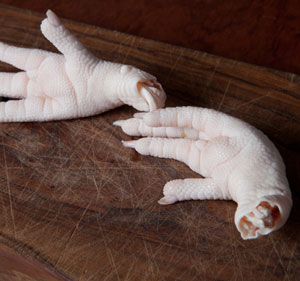 These feet were made for woking. Or perhaps you like your chicken feet braised?
These feet were made for woking. Or perhaps you like your chicken feet braised?
Chicken Feet
In many countries, when you visit the meat market and go looking for a chicken, you get the whole bird, head and toes included. I'm not quite sure what to do with a chicken head (although the cockscomb from a rooster is a delicious little morsel), but chicken feet feature in a classic dim sum dish where they're braised or steamed or made into quick snacks.
You probably won't find chicken feet next to bags of Doritos any time soon. The feet are rather boney and cartilaginous, with precious little meat. The idea is to suck out a few bits of meat and savor the flavor. For something a little less adventurous, toss a few feet into simmering pot of chicken broth (you do make your own chicken broth, don't you?). The feet add a luxurious, satiny mouth feel that comes from the gelatin in the feet.
Dai Thanh, 420 S. Second St., San Jose. 408.287.3744. 408.435.8888.
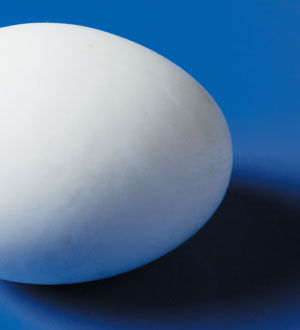 Balut looks like an egg, but inside is a boiled duck embryo.
Balut looks like an egg, but inside is a boiled duck embryo.
Balut
The first time I heard about balut, I was on an informal tour of San Jose Vietnamese restaurants. My Vietnamese-born guide knew I was game to eat just about anything, but she stopped short when the subject of balut came up. She shook her head dismissively as if to say, "There are certain lines you are not meant to cross.' And she was right.
Balut is a fertilized duck egg that's been allowed to develop into an embryo and then boiled in the shell. The snack is eaten in Vietnam, China, the Philippines and elsewhere in Asia. The age of the embryo varies, from 17 to 21 days. At 21 days the tiny bird starts to get a little crunchy but tender when cooked. Balut is commonly served as a salted snack with beer. That should tell you something. Lion Supermarket sells them for 89 cents each.
Lion Supermarket, 1031 E. Capitol Expwy., San Jose. 408.238.4451.
 Chinese roasted ducks beckon passersby from the window of Ton Tho Tuong BBQ in San Jose. Photo by Jamie Soja
Chinese roasted ducks beckon passersby from the window of Ton Tho Tuong BBQ in San Jose. Photo by Jamie Soja
Chinese Roasted Ducks
Americans like their meat cut into pieces and wrapped in plastic on a little Styrofoam tray so that we can't recognize it was actually once an animal killed to feed us. Talk about bizarre food. The Chinese don't see it the way. Walk down the streets of a big-city Chinatown and you'll see butcher shop windows with mahogany-tinted, Cantonese-style glazed ducks hanging from the necks below their lifeless heads. It's perhaps gross at first, but then rather beautiful considering the technique and skill that goes into roasting a duck.
Silicon Valley doesn't have the legions of Chinese butchers that San Francisco does, but we do have Ton Tho Tuong BBQ and Restaurant, the Chinese barbecue joint on Santa Clara with a Vietnamese name. The glistening ducks hang in the front window. Point to one you like, have the guy turn it around to see it was properly roasted and then watch as he hacks it up with a cleaver and boxes it up to go. What you do with the head is up to you, but duck tongue is a real treat.
Ton Tho Tuong, 505 E. Santa Clara St., San Jose. 408.298.2257.
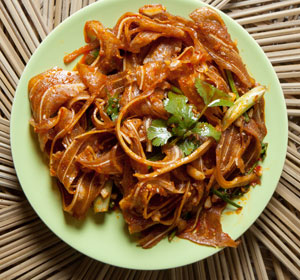 The white bands of cartilage that run through the ribbons of sliced pig's ear at South Legend Sichuan add a satisfying crunch to the dish. Photo by Jamie Soja
The white bands of cartilage that run through the ribbons of sliced pig's ear at South Legend Sichuan add a satisfying crunch to the dish. Photo by Jamie Soja
Pig's Ear
From a diner's perspective, the pig is an extraordinary animal. There's bacon, of course. And pork chops, ribs and shoulder. A pig's jaw muscle makes guanciale, a kind of superbacon. You can eat the skin (chicharrones) and even the feet (trotter). The snout goes into sausage.
At South Legend Sichuan Restaurant in Milpitas, there are displays of ribbons of pig ears in a Szechuan pepper and chile oil sauce. The pig ears are more of a textural experience than a flavorful one. The ears have a squeaky, slightly crunchy quality, but not much taste. They're really just a spicy-sauce delivery device.
South Legend Sichuan Restaurant, 1720 N. Milpitas Blvd., Milpitas. 408.934.3970.
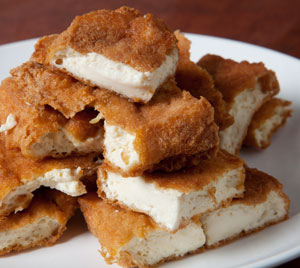 Stinkier by the dozen. Stinky tofu looks innocuous enough until you take a whiff—or a bite. Photo by Jamie Soja
Stinkier by the dozen. Stinky tofu looks innocuous enough until you take a whiff—or a bite. Photo by Jamie Soja
Stinky Tofu
For different reasons, Asian countries don't eat much cheese or drink milk. In Japan and China, tofu stands in for cheese, and soy milk replaces milk. Soy bean–based products are wonderfully versatile and can be turned into any number of foods. Since tofu is something like vegetarian cheese, it's easy to understand why someone thought of fermenting and aging it like cheese. But it's harder to understand why they would eat it.
Stinky tofu is a popular snack in Taiwan and southern China, the cuisines of which are well represented in Silicon Valley. I tried stinky tofu several years ago at the now-closed Shinbala restaurant. Here's what I wrote back then: "As the name implies, stinky tofu is indeed stinky. But stinky sounds cute and friendly like a baby fart. Stinky tofu is on another plane of stankiness. It's like eating garbage inside a sewer on a hot day.' And yet, if you can get past the smell, the flavor is not unlike a very ripe blue cheese. It's an acquired taste, to say the least.
Taiwan Bistro, 1310 Saratoga Ave., San Jose. 408.984.3440.
Offal
Silicon Valley's izakaya restaurants are the equivalent of tapas joints, bars that serve small plates of food. We don't have many tapas restaurants, but the South Bay is loaded with izakayas. The beer-and-sake joints are open to all, but they definitely have a macho edge to them.
The odd cuts of beef, pork and chicken are generally salty, grilled or fried—man food. Beef tongue is a common item, but San Jose's Dan restaurant has a more extensive menu of offal, or organ meats. There's a whole section on the menu devoted to guts and such, including honeycomb tripe, cartilage, intestines (large or small) and gizzards. Dan also offers a plate of pork cheeks, something I've put on my go-back-and-try list.
Dan, 1306 Saratoga Ave., San Jose. 408.249.6020.
 As far as weird foods go, the crickets at Mezcal in San Jose are easy to like—crunchy, salty and sour. Photo by Jamie Soja
As far as weird foods go, the crickets at Mezcal in San Jose are easy to like—crunchy, salty and sour. Photo by Jamie Soja
Grasshoppers
Like many of the edible insects I've tried, grasshoppers are easy to love. Like wax worms, meal worms, ant eggs and caterpillar larvae, crickets are loaded with fat and pound for pound are much better for you than beef or pork. They also require far fewer food and land resources to produce.
Grasshoppers are a good place to begin. Known as chapulines in Mexico, the little orthopteras have been eaten since pre-Colombian times, so there's no reason to stop now. The insects are roasted with salt and chiles until they're wonderfully crunchy. A squeeze of lime finishes them off. They're eaten a salty beer snack or an appetizer.
Mezcal, 25 W. San Fernando St., San Jose. 408.283.9595.
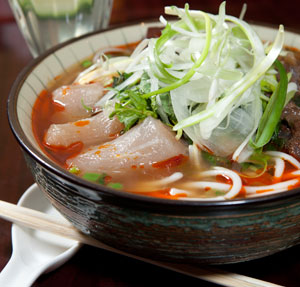 The addition of beef penis, those whitish ingredients on the left, takes a bowl of bun bo hue to the next level. Photo by Jamie Soja
The addition of beef penis, those whitish ingredients on the left, takes a bowl of bun bo hue to the next level. Photo by Jamie Soja
Ox Penis
Bun bo Hue is pho's spicier cousin. The beef noodle soup has a richer broth that's aromatic with lemongrass and other spices. Chile oil is drizzled in as well to give it greater body and spiciness. As you might guess from the name, San Jose's Bun Bo Hue An Nam specializes in the central Vietnamese soup. Look around and just about every person is slurping down a bowl of the stuff. Look a little closer, and you'll see that in addition to tender pieces of beef shank and pork, some diners are enjoying a bite of bull penis.
It's described as ox penis on the menu, but it doesn't come from an ox any more than oxtails come from an ox. The organ is question doesn't look like the sausage you might expect. It's whitish and looks and tastes like a tendon, a little chewy with a soft, gelatinous crunch to it. There's not much flavor. That comes from the soup broth. Ox penis is no biggie, well it is, but you know what I mean. What gets me are the cubes of reddish brown congealed pork blood that also comes with the soup. To me that's gross.
Bun Bo Hue An Nam, 740 Story Road, San Jose. 408.993.1755.
Geoduck
Fans of dim sum will recognize the geoduck. Pronounced gooey-duck, it's the longest-living and largest clam in the world. The necks of bivalves grow up to 3 feet long and can live up to 140 years. The muscular, wrinkled neck isn't as sweet or tender as the more common littleneck clam, but geoducks are prized in Chinese cuisine. One clam can go for $40. The beefy shellfish are tough to wrestle with at home and have to be cleaned while still alive. Best to leave it to an expert.
ABC Seafood, 768 Barber Lane, Milpitas. 408.435.8888.


